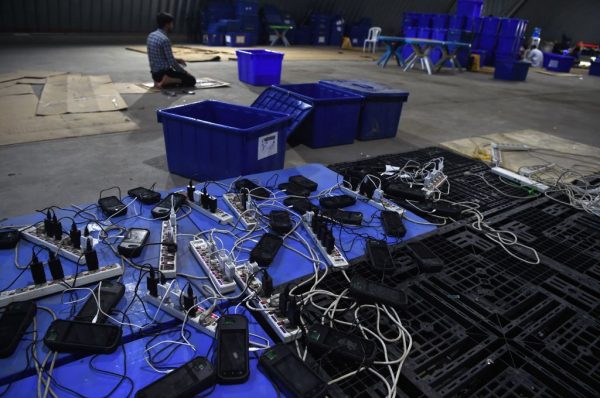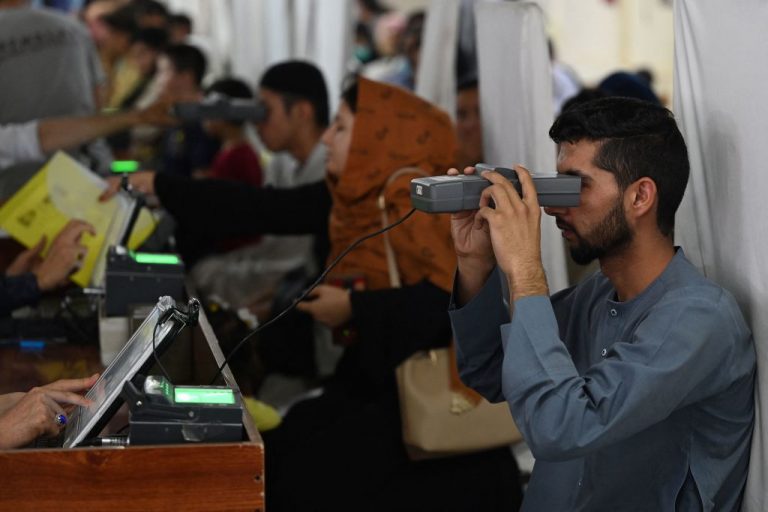A Taliban-linked special forces unit is utilizing U.S. biometric hardware and a database connected with it left behind by the defeated Afghanistan government to hunt down citizens who are friendly to NATO, according to reports.
The New York Post published an Aug. 27 article relying on an interview conducted by Zenger News, which is not published on the Zenger website, with Nawazuddin Haqqani, a brigade commander of the Al Isha special forces unit. Haqqani was paraphrased as saying “that his unit is using US-made hand-held scanners to tap into a massive US-built biometric database and positively identify any person who helped the NATO allies or worked with Indian intelligence.”
“Afghans who try to deny or minimize their role will find themselves contradicted by the detailed computer records that the US left behind in its frenzied withdrawal.”
Haqqani was quoted by Zenger as saying in a phone interview, “Now that Kabul is taken, operational work has taken a back seat and we’ve turned our focus on counterintelligence…While most of the brigade is now resting in different madrassas [Islamic religious schools], the Al Isha group is now the principal agency handling this [biometric] data project.”
“We’re in control of the Interior Ministry and the national biometric database they kept. We have everyone’s data with us now — including journalists and so-called human rights people. We haven’t killed a single foreign journalist, have we? We aren’t arresting the families of these people [who are on the blacklist] either,” he continued.
Success
You are now signed up for our newsletter
Success
Check your email to complete sign up
Haqqani’s commentary then became darkly morose, “But American, NDS [Afghanistan’s National Directorate of Security] and RAW’s [India’s Research and Analysis Wing] puppets won’t be let off. They will always be watched by Al Isha. Those who were barking about having US dollars in their pockets till a few days back — they won’t be spared. They can’t be spared, can they?”
The Post says the existence of Al Isha was not confirmed by the Taliban until this interview, and that the Haqqani Network, a “terror group aligned with the Taliban,” had not admitted it was targeting Afghans or using the U.S. biometric database.
According to the U.S. National Counterterrorism Center’s website, the Haqqani Network is described as a Sunni Islamist military organization headquartered in Pakistan that is closely allied with the Taliban today. Its founder, Jalaluddin Haqqani, is described as a mentor to Usama Bin Laden.
The NCC describes the group, which was added to the Foreign Terrorist Organization list in 2012, as “The most lethal and sophisticated insurgent group targeting US, Coalition, and Afghan forces in Afghanistan,” adding it is responsible for the 2011 attack on the Kabul International Hotel and 2008 and 2009 suicide bombings against the Indian Embassy.
The Post said the loss of the biometrics database is a weighty one with serious implications, “Virtually everyone who worked with the Afghan government or the US military, including interpreters, drivers, nurses, and secretaries, was fingerprinted and scanned for the biometric database over the past 12 years.”

The Biden Administration declined to immediately answer questions posed by both Zenger and The Post on the 7,000 biometric scanners lost to the Taliban by the U.S. military or if the database could be secured or deleted remotely.
The database was apparently housed on servers located in the Ministry of Interior in Kabul and lost when the Taliban sacked the capital and expelled the preceding government. The Post says the database, which contains sensitive data such as iris scans and fingerprints, started with information from 300,000 Afghan prisoners and soldiers in 2009, ballooning to at least 25 million of Afghanistan’s 38 million citizens according to a National Public Radio report in 2020.
However, the actual size of the database is classified.
The Post recounted a telling example of the implications of the database loss through the story of a 26-year-old former Afghan National Army commander who was spoken with by telephone just hours after the Taliban seized Kabul on Aug. 16. He said he had managed to safely return home with his parents, wife, and child, “But I don’t think I will be here for long. They’re going door to door and scanning everyone with biometric scanners, and they’ll knock on my doors anytime now.”
When the soldier was asked if it was the Taliban who were running the door-to-door scans, he replied, “The Al Isha actually.”
“The Afghan Taliban are incapable of handling the biometric equipment or the database…Every search party is overseen by a Pakistani officer or a member of the Haqqani Network.”
The Post says the commander’s phone is no longer in service.
On Aug. 26, Politico reported Biden administration officials had voluntarily handed a list of American citizens, green card holders, and allies in Afghanistan for the purposes of allowing those people access to Kabul Airport for evacuation.
An anonymous U.S. defense official told the outlet, “Basically, they just put all those Afghans on a kill list..It’s just appalling and shocking and makes you feel unclean.”
Politico said, “The Biden administration has been relying on the Taliban for security outside the airport,” and that the administration’s officials felt giving the Taliban intelligence was “the best way to keep Americans and Afghans safe and prevent a shooting war between Taliban fighters and the thousands of U.S. troops stationed at the airport.”
Another unnamed U.S. official was quoted as saying, “They had to do that because of the security situation the White House created by allowing the Taliban to control everything outside the airport.”
Politico was unable to get a clear answer from President Biden, the NSC, or U.S. Central Command on whether the list exists and whether it was given to the Taliban.
The Taliban has shown abject disrespect for the U.S. government at least twice since taking Afghanistan. Last week, photos were released of another Taliban special forces unit, the Badri 313 battalion, who published a propaganda photo of soldiers in full U.S. military equipment hoisting a Taliban flag in the same pose as the iconic World War II photo taken in 1945 by Associated Press photographer Joe Rosenthal from Iwo Jima where six U.S. soldiers hoisted the Stars and Stripes on Mount Suribachi.
On Aug. 17, photos emerged on Twitter of Taliban forces dressed in U.S. military gear posing for a photo while holding ice cream in their hands, a reference to Joe Biden’s enjoyment of ice cream during multiple photo opportunities from that dates back to at least 2008 when he served as Barack Obama’s running mate.


















